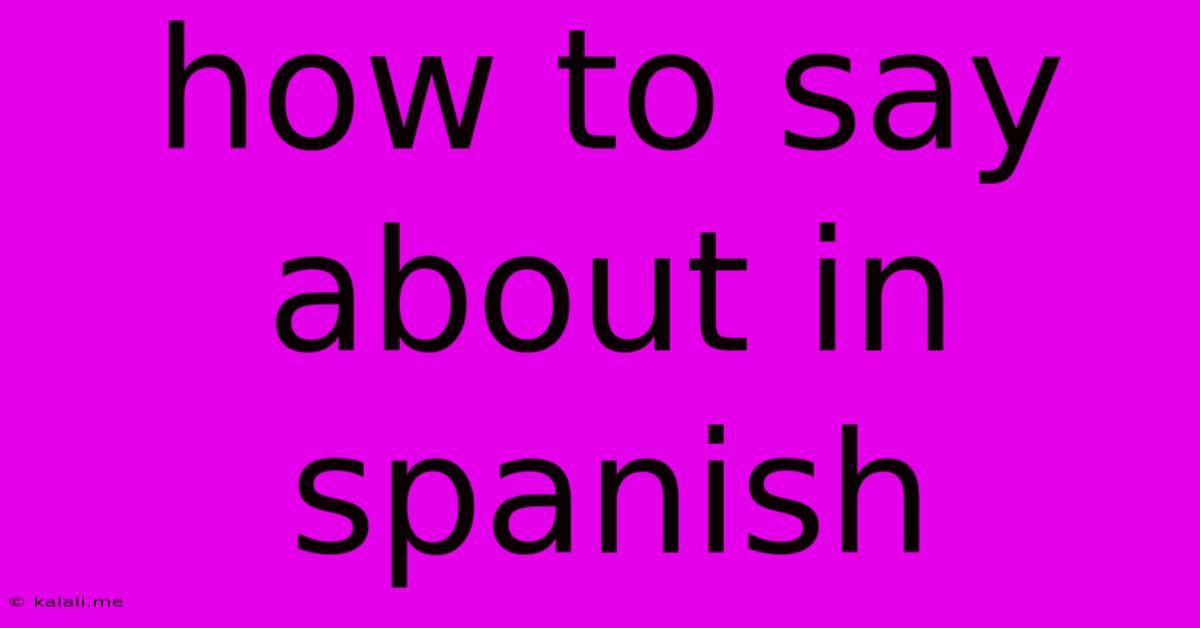How To Say About In Spanish
Kalali
May 19, 2025 · 3 min read

Table of Contents
How to Say "About" in Spanish: A Comprehensive Guide
Knowing how to say "about" in Spanish can be tricky, as there isn't one single perfect translation. The best choice depends heavily on the context. This comprehensive guide will explore the various ways to express "about" in Spanish, covering nuances and providing examples to help you choose the most accurate translation for your specific situation. This will improve your overall Spanish vocabulary and help you communicate more effectively.
What are you trying to say? This will determine the best translation. Think about the meaning of "about" in your English sentence. Are you talking about a topic, an approximation, a timeframe, or something else entirely? This seemingly small word has a lot of subtle differences in meaning.
1. Talking About a Topic or Subject: Acerca de, Sobre
The most common ways to say "about" when discussing a topic or subject are acerca de and sobre. Both translate to "about," but there's a subtle difference:
-
Acerca de: This phrase is generally preferred for more formal situations and often implies a more detailed discussion. Think of it as focusing on the specific topic at hand.
- Example: "Estoy leyendo un libro acerca de la historia de España." (I'm reading a book about the history of Spain.)
-
Sobre: This is a more versatile option, suitable for both formal and informal contexts. It can be used interchangeably with acerca de in many cases.
- Example: "Vamos a hablar sobre el proyecto." (Let's talk about the project.)
2. Expressing Approximation: Aproximadamente, Cerca de, Unos
When using "about" to indicate an approximation of a number or quantity, you have several options:
-
Aproximadamente: This is the most direct translation, meaning "approximately."
- Example: "Aproximadamente 100 personas asistieron al evento." (Approximately 100 people attended the event.)
-
Cerca de: This translates to "near" or "close to," effectively conveying approximation.
- Example: "Vivo cerca de la playa." (I live near the beach.) While this doesn't directly translate to "about," the context conveys approximation of distance.
-
Unos/Unas: This uses indefinite articles ("some") to express approximation, particularly with numbers. Use "unos" for masculine nouns and "unas" for feminine nouns.
- Example: "Hay unos 20 libros en la estantería." (There are about 20 books on the shelf.)
3. Referring to a Timeframe: Alrededor de, Hacía
To express "about" in relation to a time, use these options:
-
Alrededor de: This means "around" and is commonly used for approximate times.
- Example: "Llegaremos alrededor de las 7." (We'll arrive around 7 o'clock.)
-
Hacía: This translates to "towards" or "around" and is useful for indicating a time in the past.
- Example: "Hacía las 3 de la tarde, empezó a llover." (Around 3 in the afternoon, it started to rain.)
4. Other Contexts: De, Con
In certain other contexts, different words may be needed:
-
De: This can translate to "of" or "about" depending on the context. It often appears in phrases discussing the characteristics of something.
- Example: "Esa es una historia de amor." (That's a love story.) Here, "de amor" describes the story.
-
Con: This can sometimes convey the sense of "about" when discussing a topic in the context of a certain approach or method.
- Example: "Hablé con él sobre el problema." (I talked with him about the problem.) - While sobre is the key here, con adds context of who you talked to
Mastering the nuances of "about" in Spanish requires practice and attention to context. By understanding these different options and their subtle differences, you can significantly improve the accuracy and fluency of your Spanish communication. Remember to consider the specific meaning you wish to convey and choose the most appropriate translation accordingly. This will elevate your Spanish proficiency to a higher level.
Latest Posts
Latest Posts
-
I Look Forward To Seeing You
May 19, 2025
-
Can You Add Water To Coolant
May 19, 2025
-
How Long Does Caulk Take To Dry
May 19, 2025
-
How To Dial Italy From Uk
May 19, 2025
-
How Long Will Homemade Cheesecake Last
May 19, 2025
Related Post
Thank you for visiting our website which covers about How To Say About In Spanish . We hope the information provided has been useful to you. Feel free to contact us if you have any questions or need further assistance. See you next time and don't miss to bookmark.